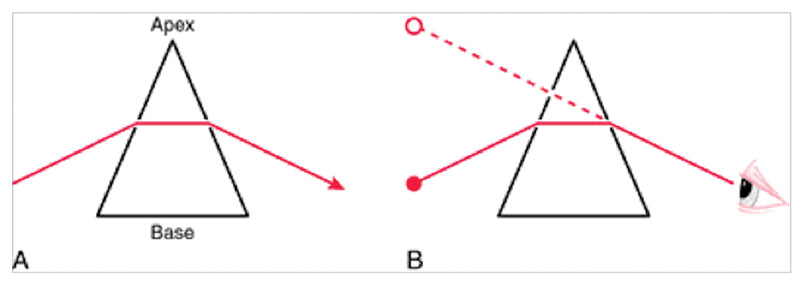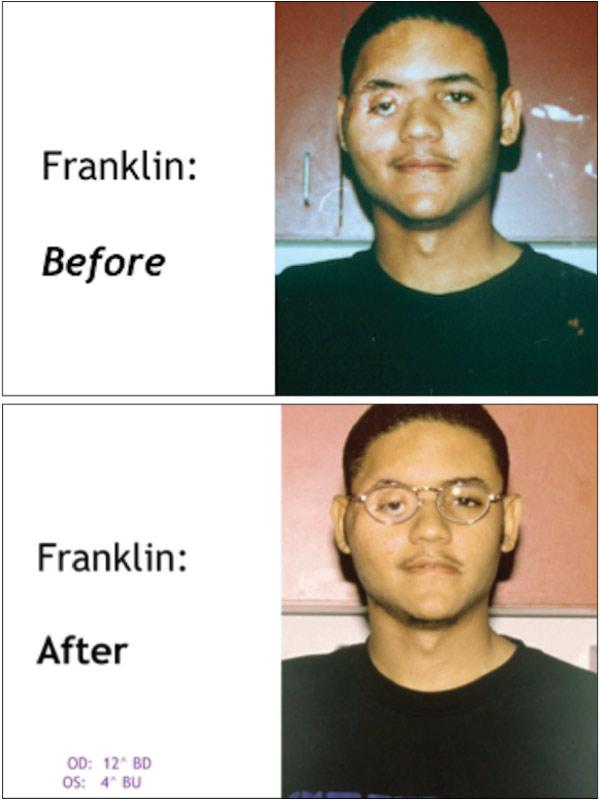 Dear Fabulous Readers,
Dear Fabulous Readers,Ms. Specs is sending her very best regards to all of you. You have stepped up to our new challenges as ECPs and are rocking it!
I thought it would be nice to take a break from COVID-19 and share an idea with you regarding “optical makeovers” and prosthetics. Recently I was searching for a PowerPoint file and came across an oldie but goodie that I wanted to share with you.
Years ago, my dear friend “Jimmy” (James Magay, owner-operator at Magy & Barron Eye Center) contacted me about a prism question. His client had a prosthetic eye (OD) which was placed quite low in the skeletal orbit, causing an aesthetic challenge. James called me and asked if I knew of a prism formula to calculate how many prism diopters (Base Down) would be required to give the illusion of the prosthetic eye being higher, matching the eye with sight. What an amazing idea! We know that when light passes through a prism, the light ray bends to the base, and the image is displaced toward the apex.
Well… Ms. Specs has many prism formulas, but not one that deals with this unique goal. So I contacted the author of our “optical bible” System for Ophthalmic Dispensing, Clifford Brooks, OD. Dr. Brooks responded that there is no exact formula, but to hold trial lenses with BD prism until the desired displacement is achieved. He added that it is also OK to add up to 4 prism diopters in the other direction in the eye with sight, to split the prism if necessary. He then added this subject to the second and third editions of his textbook.
This idea motivated me to write a paper about this subject. I reached out to a local ocularist in our area and asked for referrals. The ocularist sent me a patient (pictured here) whose prosthetic eye was placed quite low. The patient, Franklin, is a young man who was in a devastating car accident four years prior to our meeting him. He agreed to allow us to share his pictures. As you can see in the “before” picture, his OD prosthetic eye is placed quite low. Franklin was four years post-op, and the ocularist could not fix the cosmetic outcome regarding height.
After placing handheld prism lenses in front of his prosthetic eye, we discovered that it would have taken 20 Diopters of BD prism to achieve the desired effect. The resultant thickness from this would be too much… after all, this is a cosmetic makeover. Remembering Dr. Brooks’ good advice, we considered 4 prism diopters BU in the eye with sight (OS). Even then, it would have left us with 16 prism Diopters BD OD.
Observing that most people’s eyes are not perfectly symmetrical, we decided on:
OD: 12D△BD
OS: 4D△BU
The results were fabulous! Franklin had been wearing a patch covering his right prosthetic eye for four years. Better to be a cool pirate than to enter society with the insecurity that he developed due to the cosmetics. We made him two pairs, and when he left our clinic, it was the first time he went out in public without his patch. We all cried.
We then did an optical makeover with one of our opticianry students. Her prosthetic eye was larger than her eye with sight. We gave her minus lenses (approximately -6.00 D) with a little BD prism. Not only did it minimize the image of her prosthetic eye, but it also darkened the color, providing a perfect color match to her other eye. Please note: These optical makeovers can ONLY be done with a patient who is completely monocular, with a prosthetic eye. This cannot be done with patients who are amblyopic, or those who require a “balance” or “fogged” lens.
And the icing on the cake is this: If someone has had to have an eye removed due to trauma or disease, it is urgent that they wear a protective lens (like polycarbonate or Trivex) in front of the eye with sight, even if they are plano.
I hope you enjoyed this tip, and Ms. Specs is sending you her best wishes as you continue to be the rock stars of dispensing.
See Well and Be Well,
Ms. Specs in the City
Laurie Pierce, ABOM
Do you have a question for Ms. Specs? Please send your question to [email protected], and we may feature it in a future column.













